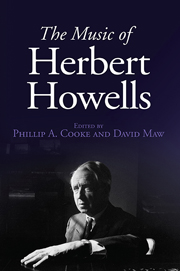Book contents
- Frontmatter
- Dedication
- Contents
- List of Illustrations
- List of Musical Examples
- List of Tables
- List of Contributors
- Foreword
- Acknowledgements
- Miscellaneous Frontmatter
- Introduction: Paradox of an Establishment Composer
- PART I Howells the Stylist
- PART II Howells the Vocal Composer
- PART III Howells the Instrumental Composer
- 7 ‘From “Merry-Eye” to Paradise’: The Early Orchestral Music of Herbert Howells
- 8 Lost, Remembered, Mislaid, Rewritten: A Documentary Study of In Gloucestershire
- 9 Style and Structure in the Oboe Sonata and Clarinet Sonata
- PART IV Howells the Modern
- PART V Howells in Mourning
- Appendix: Catalogue of the Works of Herbert Howells
- Bibliography
- Index of Works
- General Index
9 - Style and Structure in the Oboe Sonata and Clarinet Sonata
from PART III - Howells the Instrumental Composer
Published online by Cambridge University Press: 05 December 2013
- Frontmatter
- Dedication
- Contents
- List of Illustrations
- List of Musical Examples
- List of Tables
- List of Contributors
- Foreword
- Acknowledgements
- Miscellaneous Frontmatter
- Introduction: Paradox of an Establishment Composer
- PART I Howells the Stylist
- PART II Howells the Vocal Composer
- PART III Howells the Instrumental Composer
- 7 ‘From “Merry-Eye” to Paradise’: The Early Orchestral Music of Herbert Howells
- 8 Lost, Remembered, Mislaid, Rewritten: A Documentary Study of In Gloucestershire
- 9 Style and Structure in the Oboe Sonata and Clarinet Sonata
- PART IV Howells the Modern
- PART V Howells in Mourning
- Appendix: Catalogue of the Works of Herbert Howells
- Bibliography
- Index of Works
- General Index
Summary
The Oboe Sonata (HH 239 – 1942) and Clarinet Sonata (HH 251– 1946) are the only substantial chamber works dating from Howells's later period, providing an opportunity to observe his mature musical language from an alternative perspective to that presented by the choral and orchestral works. The extended forms and limited textural range facilitate an examination of elements such as thematic working, harmonic procedures at all hierarchical levels and their articulation of structural relationships, as well as the aesthetic priorities they imply. The latter will be contextualised further through a consideration of wider trends in British music and culture, drawing on comments by Howells and several of his contemporaries.
The Oboe Sonata was written for Leon Goossens, but when the oboist raised some doubts about the work's structure, Howells recalled it, saying that he would ‘have another go at it’. This was the last that was heard of it until Christopher Palmer borrowed the manuscript while working on Herbert Howells: A Centenary Celebration; luckily he made a photocopy, as the manuscript later disappeared, and the work was not performed until 1984. The Clarinet Sonata was written four years after the oboe work, for Frederick Thurston, and it resumes some of the concerns of the earlier sonata. Superficially, the Clarinet Sonata seems tighter in construction than its predecessor, avoiding some of the earlier complexities in favour of more obvious structural divisions and relationships.
- Type
- Chapter
- Information
- The Music of Herbert Howells , pp. 153 - 168Publisher: Boydell & BrewerPrint publication year: 2013



